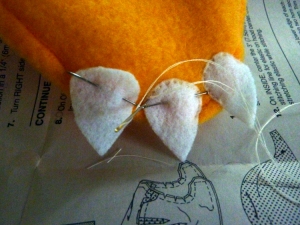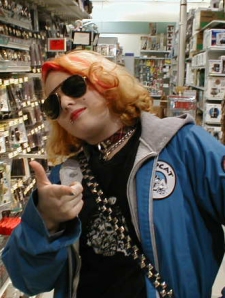Alright, we’re in the home stretch now! If you missed part one (the body) or part two (the shell) of the Bowser costume series, head that way and we’ll meet back here! If not, welcome to the most nebulous, frustrating, and free-form part of the costume – Bowser’s head! If I were to do the whole costume over again, I definitely would have started with this part, when I had some momentum! Now, a week away from Halloween, I just want to get the damn thing done. And sadly, it shows. Oh well, here we go!
Remember our Simplicity 2506 pattern? We’re going to use that again for the head. Use the pattern for the dragon head – but don’t include the spikes. It’s basically just a regular hood. Make sure you use the green fleece for his head – it’s not gold like the rest of his body. (Yep, I ended up making two hoods for that reason.) Also, cut out and sew the horns (using the cream felt) from the devil costume. Stuff, pin, and sew them onto the hood. You should set them slightly wider apart than I did.
For Bowser’s hair, draw a shape on the red felt that roughly follows the curve of the hood, with spikes on top. Make sure to account for seam allowance on the spikes when you draw them. Stack two layers of the felt and cut out your shape. Clip and fold up the bottom 1/4″ for a nicer finish (see fig. 1). Sew along the the top of the hair, turn, and press. Stuff the hair with polyfill and pin to your hood. Faster option – instead of the spikes included in the pattern, cut out the shape of Bowser’s hair and sew it in the center of the hood, just like the pattern does with the spikes. All that hand sewing takes quite a lot of time.
While you have the red felt out, cut out two eyebrow shapes, like this:
Also cut out the parts of the eyes (two of each, obviously.) You’ll need red circles for the irises, smaller black circles for the pupils, and tiny white circles for the “shine”. Cut four sort-of-ovular shapes out of the white felt for the eyeballs. Sew two of them together, leaving space to stuff, and trim the edges. Firmly stuff the eyes and close the gap. I glued the parts of the eyes together, and ran a needle and thread through the iris where the “shine” would be just to ensure that they would stay put. Sew the eyes into place, and glue the eyebrows on top of them. Faster option – 2-D eyes would be perfectly lovely, too!
Now, the mouth. Ahhh, the mouth, my biggest challenge, and biggest disappointment. I’m sure I’ll spend the next week tweaking it to try and get it to look right, but for now, here’s what I have. I really had no idea where to start. My initial idea of molding felt around ping pong balls didn’t really pan out, so I had a glass of wine or two, didn’t come up with any brilliant ideas, and decided just to make a tube out of the cream felt. I wanted to at least have some definition in the nose, so I sort of folded the edges in and sewed them in place. This created kind of a “point” at the bottom, which I folded back and sewed down. I wish I could explain that better, but I’m really not sure how.
 I stuffed the center firmly and the ends more loosely. I cut out three sets of triangles for teeth from the white felt, and sewed them onto the bottom of the mouth, pressing them down at the seam. Then I closed up the edges and sewed the whole thing to the hood.
I stuffed the center firmly and the ends more loosely. I cut out three sets of triangles for teeth from the white felt, and sewed them onto the bottom of the mouth, pressing them down at the seam. Then I closed up the edges and sewed the whole thing to the hood.
So here are the problems I’m left with: The mouth is too low and makes it difficult for my son to see out. I’m going to add some elastic to the back of the hood in hopes that it will pull the front up a bit. Also, the mouth is too wide. I want it to fold down in the middle and up at the edges a bit. Tying the ribbons under his chin helps a bit, but it’s not what I had envisioned. Anyone have any ideas? I have a week left – I’d love to hear them!


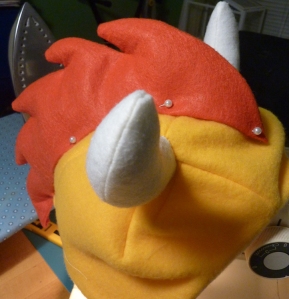



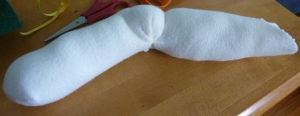
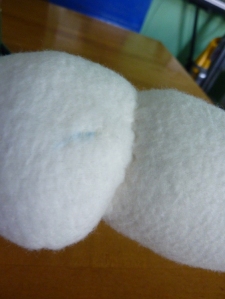


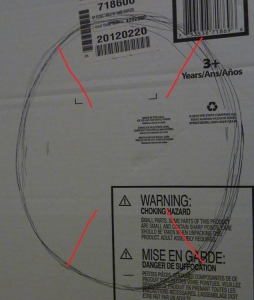


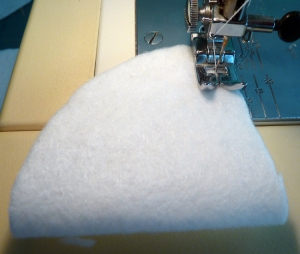

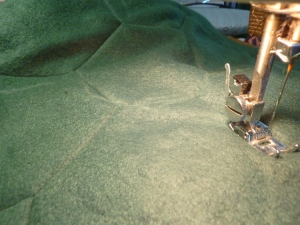




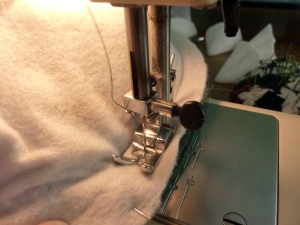

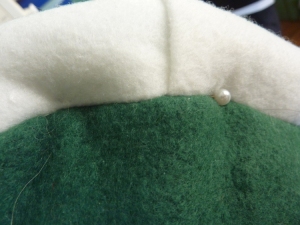
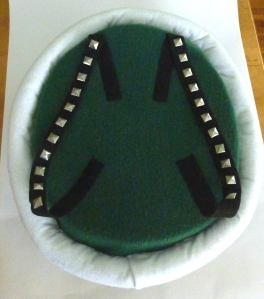
 available. I haven’t tried it, but
available. I haven’t tried it, but  This year, after some particularly inspired costume ideas (“tree,” “floor,” “mystery”) my son landed on Bowser – you know, the villain from the Super Mario Brothers franchise. Why pick a villain? Straight from his mouth: “I like monsters, and Bowser has spikes and I don’t have spikes.” Let’s remedy that, shall we?
This year, after some particularly inspired costume ideas (“tree,” “floor,” “mystery”) my son landed on Bowser – you know, the villain from the Super Mario Brothers franchise. Why pick a villain? Straight from his mouth: “I like monsters, and Bowser has spikes and I don’t have spikes.” Let’s remedy that, shall we?